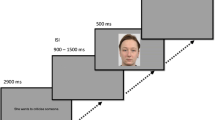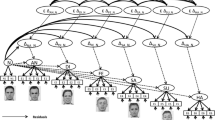The ability to recognize faces is a key skill forming our social behavior. Much attention has been focused on studies of the perception of emotional faces and expressions, though the question of the effects of context on the face recognition process has received little study. Subjects in the studies reported here watched a video clip, after which EEG recordings were made as they performed a task with photographs of the neutral faces of the characters in the film and photographs of the neutral faces of fillers (characters not appearing in the film). Studies were performed using event-related potentials (ERP). Differences were found in the amplitude of the P200 component in responses to presentation of the faces of culprits and victims, which may be associated with the different subjective significance of these stimuli for the person watching the video clip. Correlations were also found between the subjects’ personality characteristics (anxiety, aggressivity, hostility) and increases in the amplitude of the P200 component in response to the faces of victims as compared with fillers. Further studies of the effects of emotional context on the perception of faces are required.
Similar content being viewed by others
References
Barabanshchikov, V. A. and Khoze, E. G., “Perception of induced emotional expressions of calm faces,” in: 6th Int. Conf. on Cognitive Sciences, Kaliningrad (2004), pp. 142–143.
Batty, M. and Taylor, M. J., “Early processing of six basic facial emotional expressions,” Cogn. Brain Res., 17, 613–620 (2003).
Bentin, S., Sagiv, N., Mecklinger, A., et al., “Priming visual face-processing mechanisms: Electrophysiological evidence,” Psychol. Sci., 13, 190–193 (2002).
Bruce, V. and Young, A. W., “Understanding face recognition,” Brit. J. Psychol., 77, 305–327 (1986).
Caharel, S., Leleu, A., Bernard, S., et al., “Early holistic face-like processing of Arcimboldo paintings in the right occipito-temporal cortex: evidence from the N170 ERP component,” Int. J. Psychophysiol., 90, 157–164 (2013).
Dermanova, I. B., Taylor Manifest Anxiety Scale (J. Taylor, adapted by T. A. Nemchin). Diagnosis of Emotional-Moral Development, St. Petersburg (2002), pp. 126–128.
Duncan-Johnson, C. C. and Donchin, E., “The P300 component of the event-related brain potential as an index of information processing,” Biol. Psychol., 14, 1–52 (1982).
Eimler, M., Holmes, A., and McGlone, E. P., “The role of spatial attention in the processing of facial expression: an ERP study of rapid brain responses to six basic emotions,” Cogn. Affect. Behav. Neurosci., 3, No. 2, 97–110 (2003).
Eimer, M. and Holmes, A., “An ERP study on the time course of emotional face processing,” NeuroReport, 13, 427–431 (2002).
Eimer, M. and Holmes, A., “Event-related brain potential correlates of emotional face processing,” Neuropsychologia, 45, 15–31 (2007).
Eimer, M., “Attentional modulations of event-related brain potentials sensitive to faces,” Cogn. Neuropsychol., 17, 103–116 (2000a).
Eimer, M., “Event-related brain potentials distinguish processing stages involved in face perception and recognition,” Clin. Neurophysiol., 111, 694–705 (2000b).
Eimer, M., “The face-specific N170 component reflects late stages in the structural encoding of faces,” Neuroreport, 11, 2319–2324 (2000c).
Halit, H., Haan, M., and Johnson, M. H., “Cortical specialisation for face processing: face-sensitive event-related potential components in 3- and 12-month-old infants,” NeuroImage, 19, No. 3, 1180–1193 (2003).
Haxby J. V., Hoffman, E. A., and Gobbini, M. I., “The distributed human neural system for face perception,” Trends Cogn. Sci., 4, No. 6, 223–233 (2000).
Haxby, J. V., Hoffman, E. A., and Gobbini, M. I., “Human neural systems for face recognition and social communication,” Biol. Psychiatry, 51, No. 1, 59–67 (2002).
Hirai, M., Watanabe, S., Honda, Y., et al., “Emotional object and scene stimuli modulate subsequent face processing: An event-related potential study,” Brain Res. Bull., 77, 264–273 (2008).
Holmes, A., Nielsen, M. K., and Green, S., “Effects of anxiety on the processing of fearful and happy faces: An event-related potential study,” Biol. Psychol., 77, 159–173 (2008).
Holmes, A., Vuilleumier, P., and Eimer, M., “The processing of emotional facial expression is gated by spatial attention: evidence from event-related brain potentials,” Cogn. Brain Res., 16, No. 2, 174–184 (2003).
Izard, C. E., “Facial expression, emotion, and motivation,” in: Nonverbal Behavior (1979), pp. 31–49.
Jacques, C. and Rossion, B., “Does physical interstimulus variance account for early electrophysiological face sensitive responses in the human brain? Ten lessons on the N170,” Neuroimage, 39, No. 4, 1959–1979 (2008).
Kanunikov, I. E. and Fomicheva, D. A., “Reactions of the human brain to images of faces presented in an emotionally negative context,” in: The Human Face in Science, Art, and Practice, K. A. Anan’ev, V. A. Barabanshchikov, and Demidov, A. A. (eds.), Cogito-Tsentr, Moscow (2015), pp. 415–426.
Kanwisher, N., McDermott, J., and Chun, M. M., “The fusiform face area: A module in human extrastriate cortex specialized for face perception,” J. Neurosci., 17, 4302–4311 (1997).
Kaufmann, J. M., Schulz, C., and Schweinberger, S. R., “High and low performers differ in the use of shape information for face recognition,” Neuropsychologia, 51, 1310–1319 (2013).
Kolassa I. T. and Miltner W. H. R., “Psychophysiological correlates of face processing in social phobia,” Brain Res., 1118, No. 1, 130–141 (2006).
Lang, S., Nelson, C., and Collin, R., “Event-related potentials to emotional and neural stimuli,” J. Clin. Exp. Neuropsychol., 12, 946–958 (1990).
Latinus, M. and Taylor, M. J., “Face processing stages: impact of difficulty and the separation of effects,” Brain Res., 1123, No. 1, 179–187 (2006).
Lefebvre, C. D., Marchand, Y., Smith, S. M., and Connolly, J. E., “Use of event-related brain potentials (ERPs) to assess eyewitness accuracy and deception,” Internat. J. Psychophysiol., 73, 218–225 (2009).
Mer, R. J. and Taylor, M. J., “Inversion and contrast reversal affect both encoding and recognition of faces: a repetition study using ERPs,” Neuroimage, 15, 353–372 (2002).
Olofsson, J., Nordin, S., Segueira, H., and Polich, J., “Affective picture processing: An integrative review of ERP findings,” Biol. Psychol., 77, 247–265 (2008).
Peng, M., De Beuckelaer, A., Yuan, L., and Zhou, R., “The processing of anticipated and unanticipated fearful faces: An ERP study,” Neurosci. Lett., 526, 85–90 (2012).
Rivolta, D., Prosopagnosia: When All Faces Look the Same, Springer-Verlag, Berlin Heidelberg (2014).
Rossion, B., “Understanding face perception by means of human electrophysiology,” Trends Cogn. Sci., 18, No. 6, 310–318 (2014).
Rossion, R., Campanella, S., Gomez, C. M., et al., “Task modulation of brain activity related to familiar and unfamiliar face processing: an ERP study,” Clin. Neurophysiol., 110, 449–462 (1999).
Sagiv, N. and Bentin, S., “Structural encoding of human and schematic faces: holistic and part-based processes,” J. Cogn. Neurosci., 13, 937–951 (2001).
Schulz, C., Kaufman J. M., Kurt, A., and Schweinberg, S. R., “Faces forming traces: Neurophysiological correlates of learning naturally distinctive and caricatured faces,” NeuroImage, 63, No. 1, 491–500 (2012b).
Schulz, C., Kaufmann, J., Walther, L., and Schweinberger, S. R., “Effects of anticaricaturing vs. caricaturing and their neural correlates elucidate a role of shape for face learning,” Neuropsychologia, 50, 2426–2434 (2012a).
Shelepin, Yu. E., Borachuk, O. V., Pronin, S. V. et al., “The human face and the neurophysiology of nonverbal means of communication,” in: The Human Face in Science, Art, and Practice, Anan’ev, K. I. et al., (eds.), Cogito-Tsentr, Moscow (2015), pp. 449–483.
Stekelenburg, J. J. and Gelder, B., “Naso-temporal asymmetry of the N170 for processing faces in normal viewers but not in developmental prosopagnosia,” Neurosci. Lett., 376, No. 1, 40–45 (2005).
Streit, M., Wolwer, W., Brinkmeyer, J., et al., “Electrophysiological correlates of emotional and structural face processing in humans,” Neurosci. Lett., 278, 13–16 (2000).
Taylor, S. E., Phan, K. L., Decker, L. R., and Liberzon, I., “Subjective rating of emotionally salient stimuli modulates neural activity,” Neuroimage, 18, No. 3, 650–659 (2003).
Author information
Authors and Affiliations
Corresponding author
Additional information
Translated from Zhurnal Vysshei Nervnoi Deyatel’nosti imeni I. P. Pavlova, Vol. 66, No. 4, pp. 437–447, July–August, 2016.
Rights and permissions
About this article
Cite this article
Kanunikov, I.E., Pavlova, V.I. Event-Related Potentials to Faces Presented in an Emotional Context. Neurosci Behav Physi 47, 967–975 (2017). https://doi.org/10.1007/s11055-017-0498-8
Received:
Accepted:
Published:
Issue Date:
DOI: https://doi.org/10.1007/s11055-017-0498-8




